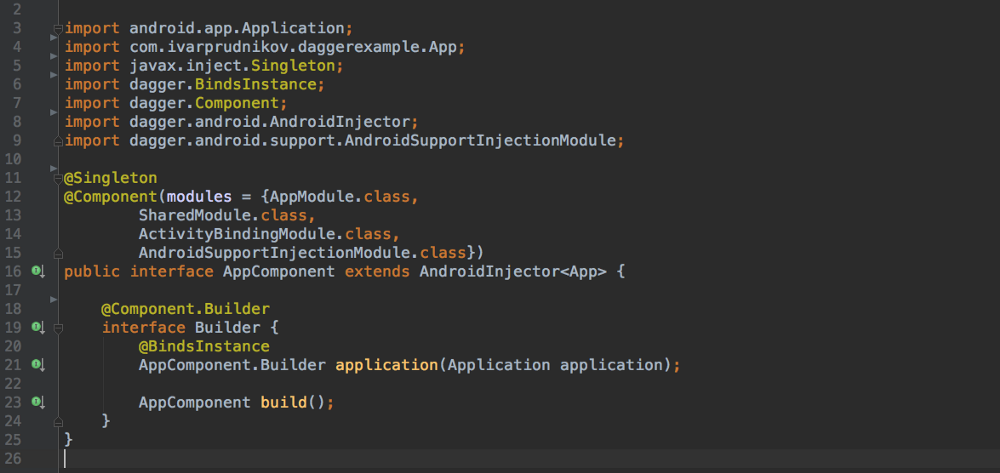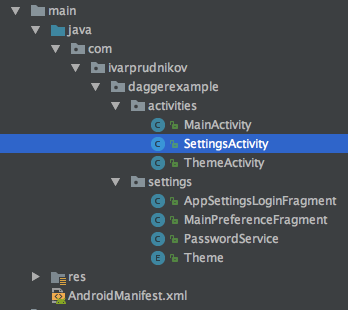Here we are, app is already in production, codebase is growing bit by bit.
This is a simple app we have — narrow use case, multiple flavours, customers extend it slowly by requesting sensible features reflecting their business needs. Build pipeline is automated, every commit triggers a build on Travis which in turn produces *.apk files that land in location used by anyone testing. App internals are not that complicated either — 10–20 conditionals checking if current customer is X or Y that switch one feature or disable another, additional text changes are managed in resource files which is natural in Android.
Everything is great until there is another customer, and another, and so on. Now all those prior conditionals, checking to see if a feature gets enabled or disabled, grow faster and it gets hard to understand effects of one change or another. But it is now possible to detect that every customer must implement defined set of feature extensions (i.e. Theme configuration), those could be configured somewhere and then added to activities; I could just use bunch of factories but DI feels like a better fit and should be a solved problem these days, or should it? Android does not have support for it natively :/
Here I’ll show couple of steps I took to add Dagger2 as dependency injection (DI) framework to an Android app. Why Dagger? it is/was recommended (not sure when you read this) in the official docs:
Dependency injection (DI): Dependency injection allows classes to define their dependencies without constructing them. At runtime, another class is responsible for providing these dependencies. We recommend the Dagger 2 library for implementing dependency injection in Android apps. Dagger 2 automatically constructs objects by walking the dependency tree, and it provides compile-time guarantees on dependencies.
Well, first what you will discover is that Dagger documentation for Android is not a 1 hour read as you need to jump from place to place to stitch everything in your mind together; imagine referring your junior developers there. Another difficulty is the amount of blog posts about its use/integration, I found they’re a bit confusing as they are divergent, with varying app structures, several setup instructions (not all using available helper classes); it complicates whole on-boarding process. Furthermore I need to mention the amount of configuration, which is necessary but initially looks excessive, it will be evident here where app is very small.
Before Dagger2
I’d love to remind my future self how I used DI in Android and for this very purpose I’ve set up a small app which is going to integrate with Dagger. I did 3 parts: main screen with greeting, theme preview and settings where user can amend greeting and theme.
Amount of code is trivial here. There is MainActivity.java which shows a greeting and a button that leads to customisable view backed by ThemeActivity.java. Theme lets user preview whatever was selected in settings screen. You can check out this version of code in GitHub. You might notice usage of Butterknife in code, I’ve added it to reduce noise of boilerplate required to set up views.
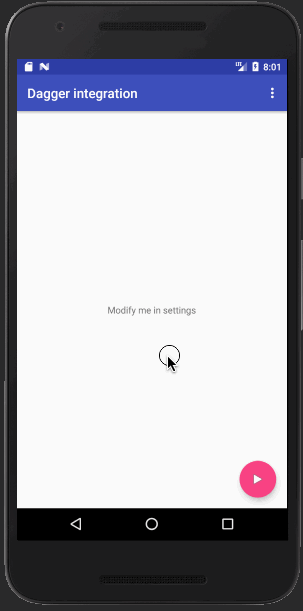
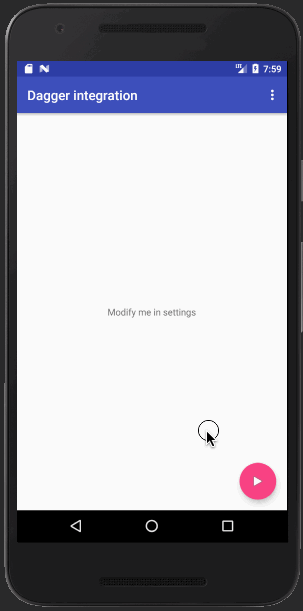
What could be refactored?
Below is a code excerpt from MainActivity and here I load SharedPreferences on each resume , I suggest this is a good candidate to be injected as preferences could easily be reused in other future/existing activities.
public class MainActivity extends AppCompatActivity {
//<...>
@BindView(R.id.home_content)
TextView homeContent;
@Override
protected void onCreate(Bundle savedInstanceState) {
super.onCreate(savedInstanceState);
setContentView(R.layout.activity_main);
ButterKnife.bind(this);
setSupportActionBar(toolbar);
}
@Override
protected void onResume() {
super.onResume();
SharedPreferences sharedPref = PreferenceManager.getDefaultSharedPreferences(this);
String welcomeKey = getString(R.string.pref_home_welcome_key);
String welcomeDefault = getString(R.string.pref_home_welcome_default);
homeContent.setText(sharedPref.getString(welcomeKey, welcomeDefault));
}
//<...>
}
Another example of what could be refactored is in ThemeActivity Following previous example we could make SharedPreferences injectable, but also the Theme itself could be instantiated and made available to activity by DI.
public class ThemeActivity extends AppCompatActivity {
@BindView(R.id.customer_content)
TextView customerContent;
@Override
protected void onCreate(Bundle savedInstanceState) {
super.onCreate(savedInstanceState);
setContentView(R.layout.activity_customer);
ButterKnife.bind(this);
}
@Override
protected void onResume() {
super.onResume();
SharedPreferences sharedPref = PreferenceManager.getDefaultSharedPreferences(this);
String themeLabel = sharedPref.getString(getString(R.string.pref_customer_theme_key), Theme.DEFAULT.getLabel());
Theme theme = Theme.fromLabel(themeLabel);
customerContent.setText(getString(R.string.activity_theme_text, theme.getLabel()));
customerContent.setBackgroundColor(theme.getBackgroundHex());
customerContent.setTextColor(theme.getForegroundHex());
}
//<...>
}
After adding Dagger2
Because I’ve had existing application and code was structured already I did create new package and called it di You might have seen it being used in other Dagger examples already.
Current setup is not finished yet, as there is an issue with theme selection — it does not change immediately after getting back from settings, but I’ll tackle it later. For now there are 7 new files!
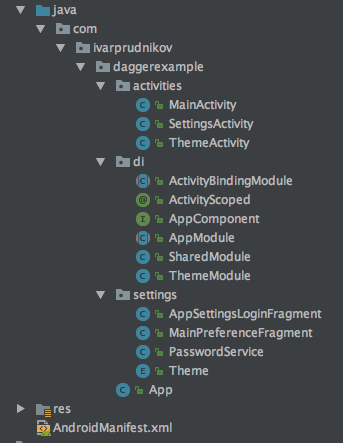
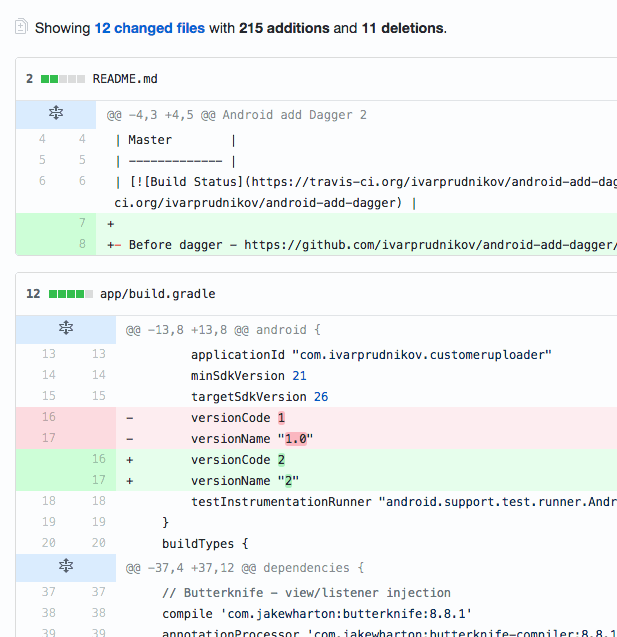
Firstly it was necessary to subclass Application and Dagger helps with it by providing DaggerApplication which hides some boilerplate code you’d need to do in order to initialise DI:
public class App extends DaggerApplication {
@Override
public void onCreate() {
super.onCreate();
}
@Override
protected AndroidInjector<? extends DaggerApplication> applicationInjector() {
return DaggerAppComponent.builder()
.application(this)
.build();
}
}
Then there are configuration classes:
-
AppComponent — I like to think of it as a root node of our dependency graph, it dies along with all its children nodes. It would also be possible to have multiple components with varying lifecycle (scope), here it is marked as Singleton and is instantiated in theApp
-
Module — configuration of your injectables, there is more that one because there are some rules that do not mix together, i.e. Binds and Provides annotated methods.
-
ActivityScoped — custom lifecycle annotation.
How did refactoring go?
As mentioned above I’ve refactored MainActivity and ThemeActivity which now contain injected SharedPreferences and Theme
public class MainActivity extends AppCompatActivity {
//<...>
@Inject
SharedPreferences sharedPreferences;
@Override
protected void onCreate(Bundle savedInstanceState) {
AndroidInjection.inject(this);
super.onCreate(savedInstanceState);
setContentView(R.layout.activity_main);
ButterKnife.bind(this);
setSupportActionBar(toolbar);
}
@Override
protected void onResume() {
super.onResume();
String welcomeKey = getString(R.string.pref_home_welcome_key);
String welcomeDefault = getString(R.string.pref_home_welcome_default);
homeContent.setText(sharedPreferences.getString(welcomeKey, welcomeDefault));
}
// <...>
}
For above to work I had to configure SharedPreferences in one of the modules used by our main component.
@Module
public class SharedModule {
@Provides
SharedPreferences provideSharedPreferences(Context ctx) {
return PreferenceManager.getDefaultSharedPreferences(ctx);
}
}
The new module SharedModule which contained Provides annotated method returned instance of preferences but it required Context to work. This context was available as we have access to application object:
@Module
public abstract class AppModule {
@Binds
abstract Context bindContext(Application application);
}
Above module configurations could not be mixed because of the Provides and Binds annotation usage. And both of them were set up in the main component:
@Singleton
@Component(modules = {AppModule.class, SharedModule.class, ActivityBindingModule.class, AndroidSupportInjectionModule.class})
public interface AppComponent extends AndroidInjector<App> {
@Component.Builder
interface Builder {
@BindsInstance
AppComponent.Builder application(Application application);
AppComponent build();
}
}
Theme activity refactoring had to follow a different path.
public class ThemeActivity extends AppCompatActivity {
//<...>
@Inject
Theme theme;
@Override
protected void onCreate(Bundle savedInstanceState) {
AndroidInjection.inject(this);
super.onCreate(savedInstanceState);
setContentView(R.layout.activity_customer);
ButterKnife.bind(this);
}
@Override
protected void onResume() {
super.onResume();
customerContent.setText(getString(R.string.activity_theme_text, theme.getLabel()));
customerContent.setBackgroundColor(theme.getBackgroundHex());
customerContent.setTextColor(theme.getForegroundHex());
}
//<...>
}
Theme injection config was similar to the SharedPreferences but it needed to be tied to its own lifecycle for it not to become stale, this was supposed to be managed by new ActivityScoped annotation:
public class ThemeModule {
@Provides
@ActivityScoped
Theme provideTheme(Context context, SharedPreferences sharedPreferences) {
String selectedTheme = context.getString(R.string.pref_customer_theme_key);
String defaultTheme = Theme.DEFAULT.getLabel();
String themeLabel = sharedPreferences.getString(selectedTheme, defaultTheme);
return Theme.fromLabel(themeLabel);
}
}
//<...>
@Documented
@Scope
@Retention(RetentionPolicy.RUNTIME)
public @interface ActivityScoped {}
Configuring module to be used in Activity
Because activities are managed by Android there is only one place to hook into their lifecycle, i.e. via provided methods like onCreate For this reason we have to send signal to DI and tell it when activity is ready to get injectables:
protected void onCreate(Bundle savedInstanceState) {
AndroidInjection.inject(this);
}
Above piece of code will get our App object which extended DaggerApplication and will try to add this Activity to the graph, and it will fail as Android constructed instances need an additional factory set up for each (for MainActivity and ThemeActivity). Fortunately Dagger gives as an ability to do it without too much code:
@Module
public abstract class ActivityBindingModule {
@ActivityScoped
@ContributesAndroidInjector
abstract MainActivity mainActivity();
@ActivityScoped
@ContributesAndroidInjector(modules = ThemeModule.class)
abstract ThemeActivity themeActivity();
}
Above module was added to main component as well. It will generate code which will contain necessary factories for each of the methods.
You can also see the ThemeModule configuration in ContributesAndroidInjector annotation used for ThemeActivity
Summary
Usage of Dagger in small applications does not make sense although I’ve introduced same pattern in the app with at least 15 activities and bunch of flavours and it made code easier to understand.
In contrary, configuration is quite hard to understand, but recently introduced helpers DaggerApplication , ContributesAndroidInjector , AndroidInjection mitigate visible complexity and boilerplate.
I haven’t touched on Scopes here yet, despite the necessity to fix small theme appearance issue in ThemeActivity after refactoring, but there are some further reading links about it below.
Versions numbers
Dagger 2 was added to the Android application with following versions:
android {
//<...>
compileSdkVersion 26
buildToolsVersion "26.0.2"
defaultConfig {
minSdkVersion 21
targetSdkVersion 26
//<...>
}
//<...>
dependencies {
//<...>
def dagger_version = "2.14.1"
implementation "com.google.dagger:dagger-android:$dagger_version"
implementation "com.google.dagger:dagger-android- support:$dagger_version"
annotationProcessor "com.google.dagger:dagger-android-processor:$dagger_version"
annotationProcessor "com.google.dagger:dagger-compiler:$dagger_version"
provided 'javax.annotation:jsr250-api:1.0'
}
}
Useful resources
- Tasting Dagger 2 on Android fernandocejas.com
- DAGGER 2 - A New Type of dependency injection youtube video
- Dagger ‡ A fast dependency injector for Android and Java. A fast dependency injector for Android and Java
- Dagger 2 : Component Relationships & Custom Scopes proandroiddev.com
- Building UserScope with Dagger2 - froger_mcs dev blog frogermcs.github.io
- Dagger 2. Part II. Custom scopes, Component dependencies, Subcomponents Dagger 2 articles cycle proandroiddev.com
